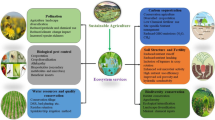Résumé
Dans cet article, l’auteur veut intéresser les acteurs de la phytothérapie à des plantes dont on ne parle que rarement et qui portent des fruits ou des baies qui ont eu une importance économique pour les populations des zones où elles poussent Ces baies, qui perdurent dans des contrées au climat difficile mais biologiquement assez protégées, ont des propriétés qui peuvent intéresser demain les amateurs de plantes alimentaires sauvages qui peuvent concourir à l’équilibre de leur santé.
Abstract
The author’s aim in this article is to raise awareness in phytotherapy professionals of little-known plants that produce fruit or berries with significant economic impact on populations living in the areas where they grow. These berries, which endure in countries with harsh, yet biologically wellprotected, climates, have properties that could interest supporters of wild food plants believed to contribute to maintaining stable health.
Similar content being viewed by others
Bibliographie
Chen Wei, Payne TJ (1998) Raspberry(Rubus L.) ACTA. Chinese Medicine and Pharmacology 4: 44–48
Choi J, Lee KT, Ha J,et al. (2003) Antinociceptive and antiinflammatory effects of Niga-ichigoside F1 and 23-hydroxytormentic acid obtained fromRubus coreanus. Biol Pharm Bull 26(10): 1436–1441
McCutcheon AR, Ellis SM, Hancock RE,et al. (1994) Antifungal screening of medicinal plants of British Columbian native peoples. J Ethnopharmacol 44(3): 157–169
Densmore F (1974) How Indians use wild plants for food, Medicine ans (and?) crafts. Dover Publications, New York
Derig BB, Fuller M (2001) Wild berries of the West. Mountain Press Publishing Company, Missoula, USA, 16
Elias T, Dykeman P (1982) A Field Guide to N. American Edible Wild Plants. Van Nostrand Reinhold
Erichsen-Brown Ch (1989) Medicinal and other uses of north American plants, a historical survey with special reference to the eastern Indian Tribes. Dover edition, New York
Erna G (1999) Ethnobotany of Wertern Washington. University of Washington Press (revised)
Kahkonen MP, Hopia AI, Heinonen M (2001) Berry phenolics and their antioxidant activity. J Agric Food Chem 49(8): 4076–82. & Herkku Riitan, www.arctic-flavour.fi/OyEmpetrum.html
Kindscher K (1992) Medicinal wild plants other Prairie. An ethnobotanical guide, University Press pf Kansas
Lengsfeld C, Deters A, Faller G,et al. (2004) High molecular weight polysaccharides from black currant seeds inhibit adhesion of Helicobacter pylori to human gastric mucosa. Planta Med 70(7): 620–626
Marquina MA, Corao GM, Araujo L,et al. (2002) Hyaluronidase inhibitory activity from the polyphenols in the fruit of blackberry(Rubus fruticosus B.). Fitoterapia 73 (7-8): 727–9
Millspaugh CF (reprint 1974) American medicinal plants: an illustrated and descriptive guide to plants indigenous to and naturalized in the United States which are used in medicine. Dover Publications, New York
Moerman D (1998) Native American Ethnobotany Timber Press. Oregon
Ohgami K, Ilieva I, Shiratori K,et al. (2005) Anti-inflammatory effects of aronia extract on rat endotoxin-induced uveitis. Invest Ophthalmol Vis Sci 46(1): 275–281
Rapp K, Næss SK, Swartz HJ (1993) Commercialization of the cloudberry(Rubus chamaemorus L.) in Norway, pp 524–526. In: Janick J, Simon JE (eds.), New crops. Wiley, New York
Robert-Lamblin J (1998) Alimentation et pratiques médicales traditionnelles des populations de la Basse Kolyma (Yakoutie). Boréales 74–77: 31–66
Rossi A, Serraino I, Dugo P,et al. (2003) Protective effects of anthocyanins from blackberry in a rat model of acute lung inflammation. Free Radic Res 37(8): 891–900
Turner NJ, Thompson LC, Thompson MT,et al. (1990) Thompson, Knowledge and usage of plants by the Thompson Indians of British Columbia, Royal British Columbia, Ethnobotany, Memoir n∘3, Canada
Turner NJ, Szczawinski A. Edible (1978) Wild Fruits and Nuts of Canada. National Museum of Natural Sciences
Viberg U, Ekström G, Fredlund K,et al. (1997) A study of some important vitamins and antioxidants in a blackcurrant jam with low sugar content and without additives. Int J Food Sci Nutr 48: 57–66
Zafrilla P, Ferreres F, Tomas-Barberan FA (2001) Effect of processing and storage on the antioxidant ellagic acid derivatives and flavonoids of red raspberry(Rubus idaeus) jams. J Agric Food Chem 49(8): 3651–3655
http:/www.arctic-flavours.fi/france/indexra.htm http://www.avataq.qc.ca/fra/aci/aci_tis2.htm
Author information
Authors and Affiliations
Corresponding author
About this article
Cite this article
Goetz, P. Baies des régions arctiques, d’Amérique du Nord et d’Eurasie septentrionale. Phytothérapie 4, 130–135 (2006). https://doi.org/10.1007/s10298-006-0166-6
Published:
Issue Date:
DOI: https://doi.org/10.1007/s10298-006-0166-6
Mots clés
- Baies des régions nordiques
- Aronia
- Amelanchier alnifolia
- Crataegus
- Empetrum nigrum
- Prunus americanum
- Ribes
- Rosa
- Rubus
- Sambucus racemosus
- Shefferdia
- Zanthoxylum americanum




